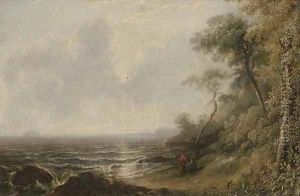Richard Parkes Bonnington Paintings
Richard Parkes Bonington was an English Romantic landscape painter, who is now most remembered for his watercolours. Born on October 25, 1802, in Arnold, near Nottingham, his family moved to Calais, France, when he was quite young, which was to have a profound influence on his career. His initial artistic influence came from his father who was also a painter. Bonington's formal art education began in Calais under the tutelage of François Louis Thomas Francia, a French artist who had fled the Revolution.
In 1818, Bonington moved to Paris to attend the atelier of Antoine-Jean Gros, where he would work alongside other prominent artists such as Eugène Delacroix. His style was influenced by the French landscape painters of the time, as well as by the Dutch masters of the 17th century. Bonington's approach to landscape was innovative, combining close observation of nature with a sense of poetic romanticism. Although he painted a few historical subjects, it was his landscapes and coastal scenes that won him acclaim.
Bonington's career was tragically short. He enjoyed a burst of success during the 1820s, exhibiting at the Paris Salon and the British Institution, and his works were collected by influential figures of the time. His health, however, was weak, and he suffered from tuberculosis. In 1828, after a prolonged period of illness, Bonington died at the young age of 25. Despite his brief career, his work had a significant impact on landscape painting, influencing the likes of Delacroix and the Barbizon school.
Bonington is particularly noted for his skill with watercolours and his ability to capture the effects of light and atmosphere. His paintings often depicted the Normandy coast and the countryside of France and Italy. He was also adept at lithography, contributing to the illustration of books such as 'Voyages pittoresques et romantiques dans l'ancienne France.' His art, characterized by a delicate touch and a light palette, was in stark contrast to the somber tones and heroic themes favored by many of his contemporaries. Despite his early death, Bonington's artistic legacy endures, with his works held in many major museums, including the Louvre in Paris and the National Gallery in London.
